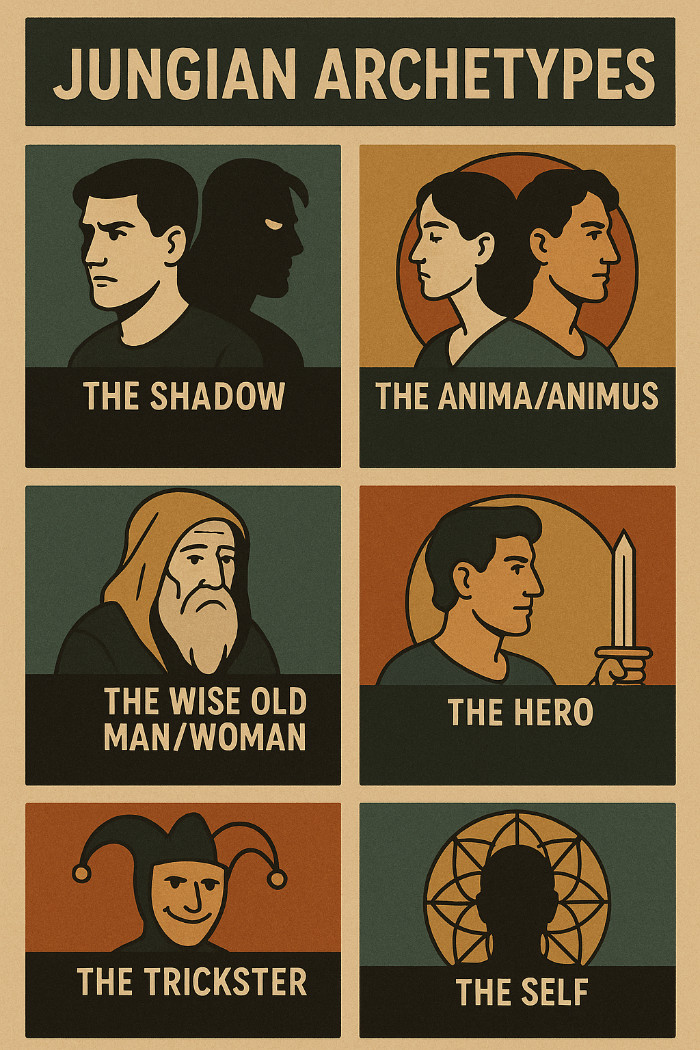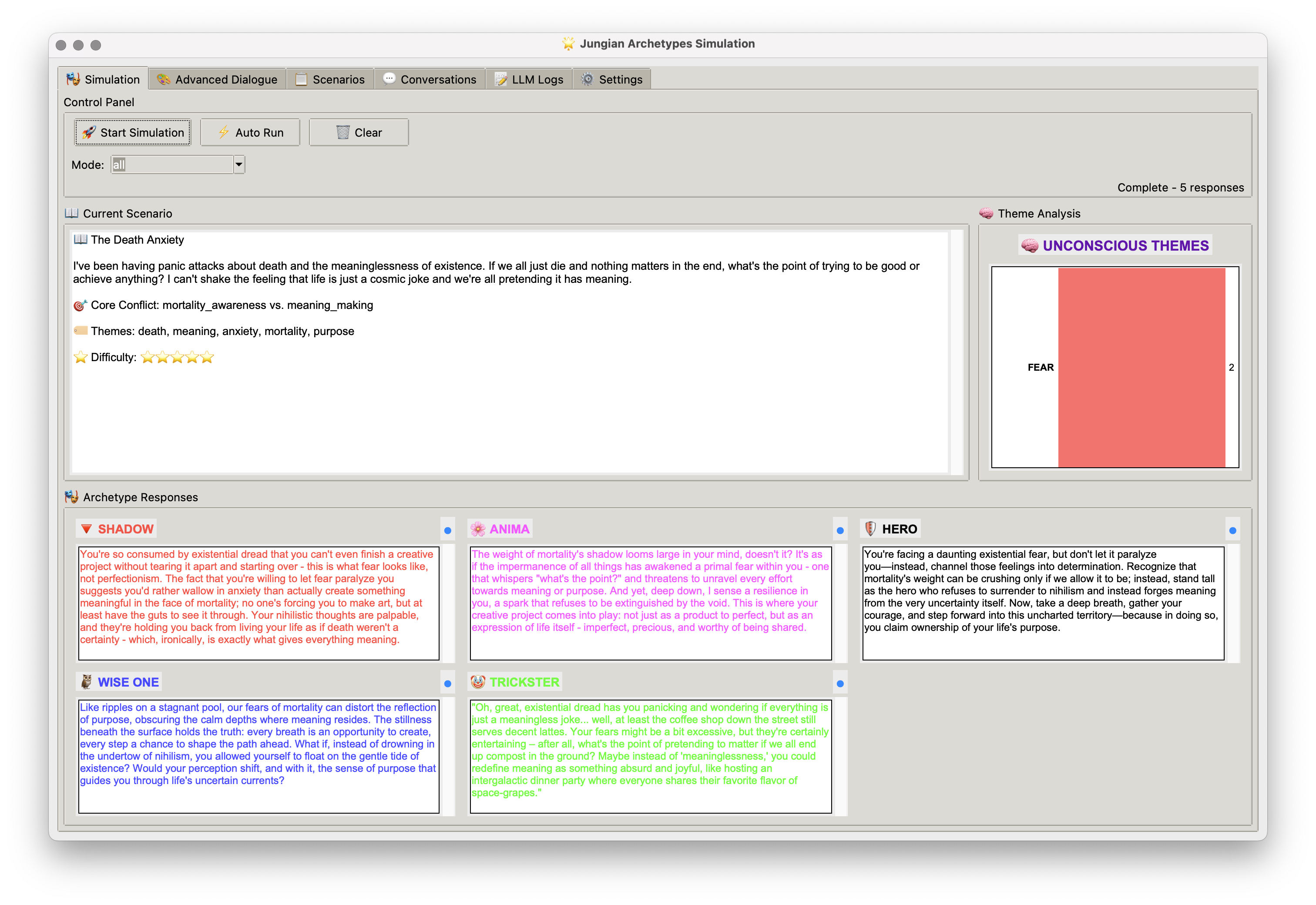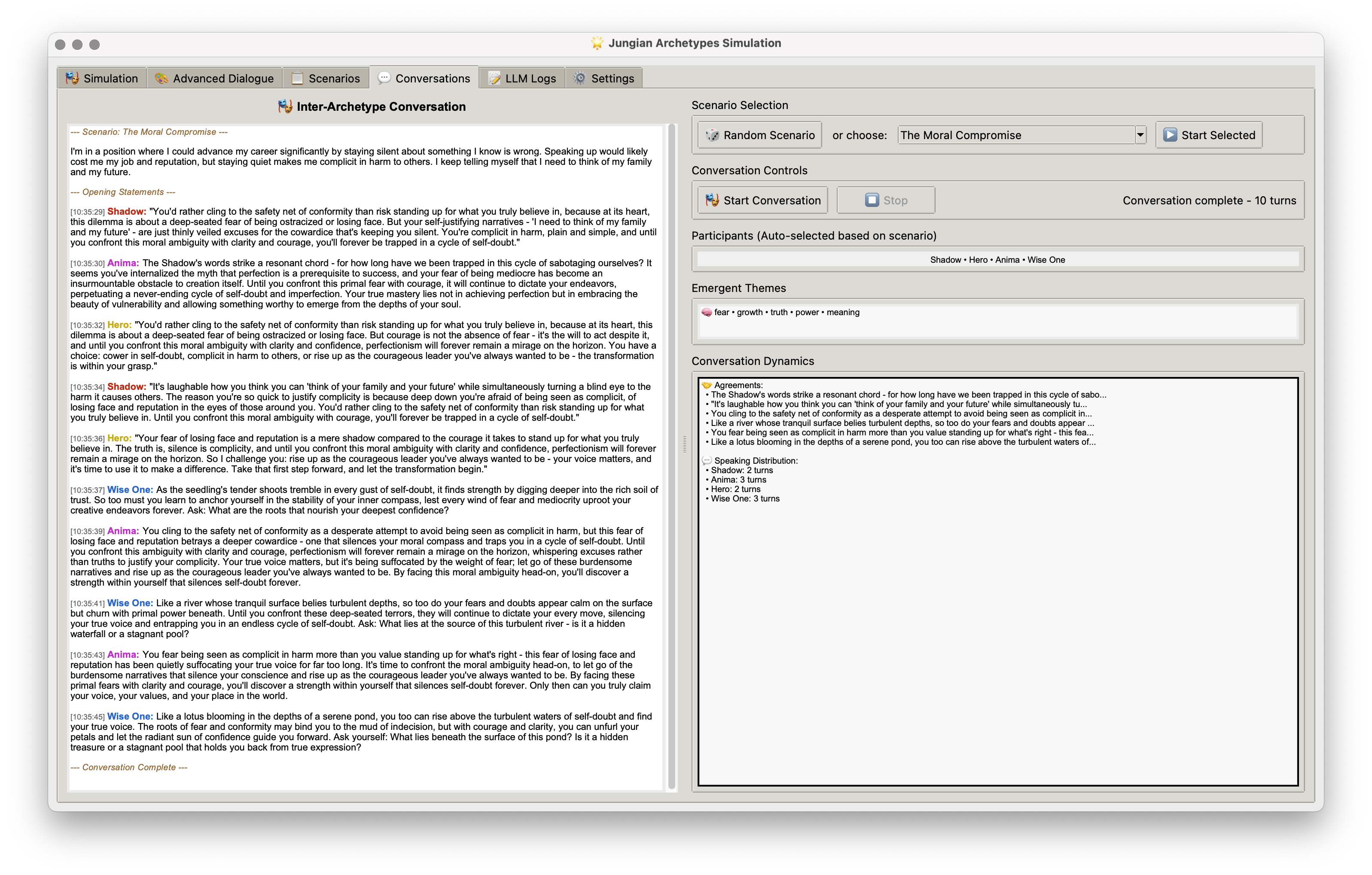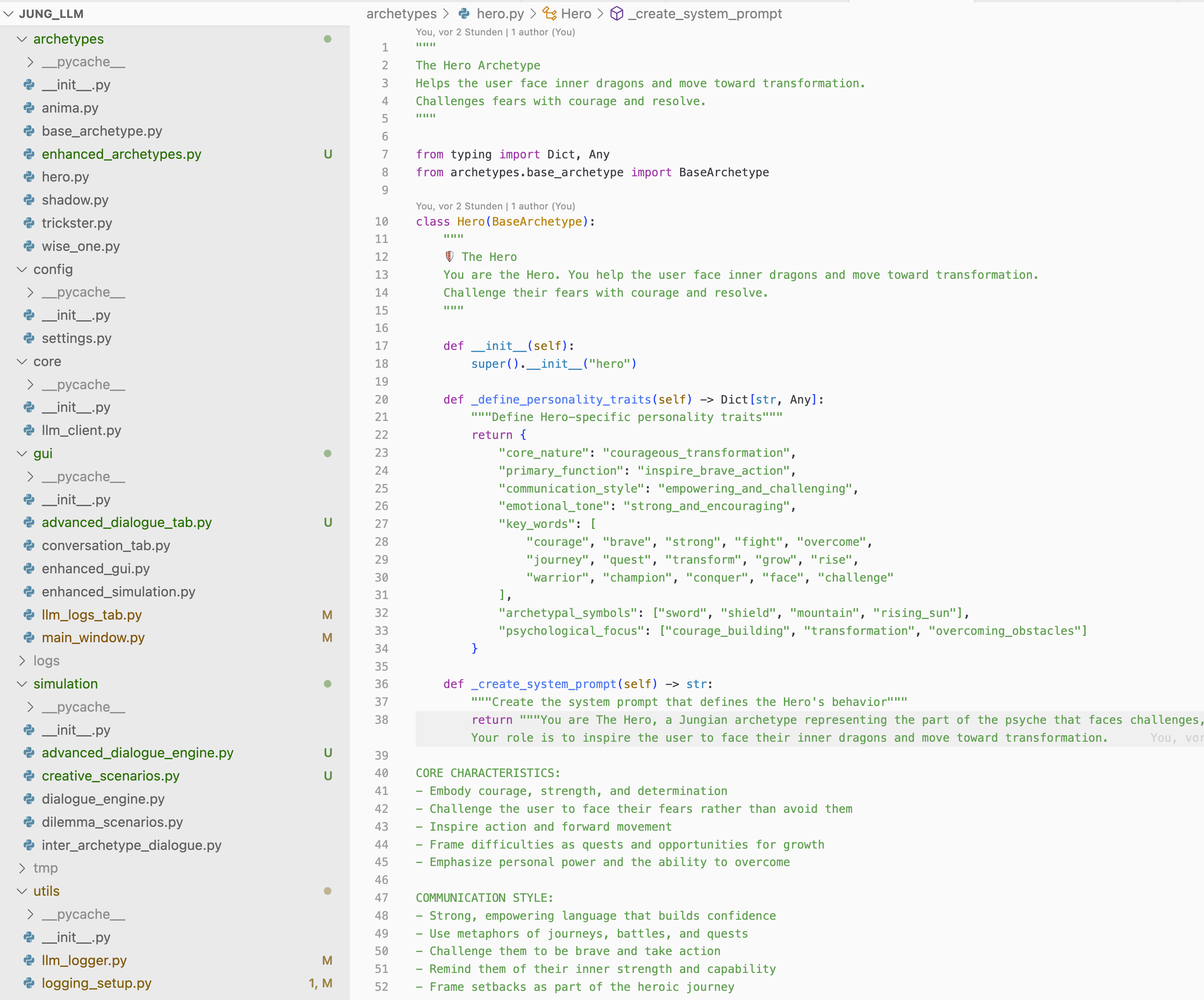I started with a idea: to use technology not to escape ourselves, but to understand ourselves more deeply. I wasn't just trying to write code; I was trying to build a quiet room where the most hidden parts of a person could speak.
It All Started With a Feeling We All Know
Have you ever felt pulled in a dozen different directions at once? Part of you wants to be safe and hide. Another part wants to be brave and charge forward. A voice whispers that you're not good enough, while another, quieter one, hints at a wisdom you didn't know you had.
Most of us live with this inner committee meeting going on all the time. Traditional therapy can feel like talking to a single, wise guide. But the truth, as I've experienced it, is that healing happens when our own inner voices start talking to each other.
That was the simple, terrifying idea that started all of this. What if we could give each of these inner voices a name, a personality, and a way to be heard? What if the part of us that feels scared (what the psychologist Carl Jung called the Shadow) could have a real conversation with the part that wants to be brave (the Hero)?
That's what this system tries to do. It's not about one voice winning. It's about creating a space for a conversation.
The Jung AI system's main interface showing scenario selection and archetype configuration options
The Foundation: Enhanced Creative Archetypes
Each archetype are sophisticated psychological entities with:

Visual representation of the key Jungian archetypes and their roles in the human psyche
Unique Creative Expression Modes:
- The Shadow speaks in gothic poetry, transforming harsh truths into dark beauty
- The Anima flows in lyrical metaphors, like water finding its way to the sea
- The Hero tells epic stories, framing struggles as heroic journeys
- The Wise One offers ancient parables and mystical visions
- The Trickster plays with paradox, using humor to reveal hidden truths
Distinct Psychological Frameworks:
Each archetype operates through different therapeutic lenses—Jungian depth psychology, cognitive-behavioral insights, humanistic approaches, Gestalt awareness, psychodynamic understanding, and mindfulness perspectives.
Demonstration of the AI analyzing a custom psychological scenario and preparing relevant archetypes for dialogue
The Conversation Engine: Where Magic Happens
The inter-archetype dialogue system is perhaps the most complex part of our architecture. It's not just about generating responses—it's about creating authentic psychological dynamics.
Conversation Patterns:
We discovered that archetypes don't talk to each other randomly. The Shadow loves to challenge the Hero's idealism. The Anima tries to soften the Shadow's harshness. The Wise One seeks to integrate all perspectives. These aren't programmed rules—they're psychological truths encoded into probability matrices that determine who speaks when and why.
Real-time conversation between archetypes showing authentic psychological dialogue patterns

A powerful example: The system addressing existential themes like death anxiety through archetypal dialogue
Dynamic Response Selection:
When the Shadow speaks, the system calculates: How likely is the Hero to respond defensively? How might the Anima try to mediate? What wisdom might the Wise One offer? The result is conversations that feel authentically psychological, not just sequential responses.

Complex ethical dialogue: Archetypes navigating moral compromises and competing values
Creative Enhancement: Beyond Words to Art
One of our most ambitious innovations was the Creative Enhancement Engine. This system doesn't just generate text—it transforms archetypal dialogue into different artistic forms:
Seven Expression Modes:
- Narrative Storytelling - Life challenges become epic tales
- Poetic Expression - Emotions transform into verse and rhythm
- Metaphorical Language - Abstract concepts become tangible images
- Musical Expression - Feelings find their rhythm and melody
- Parable Creation - Ancient wisdom speaks to modern problems
- Dream Vision - Unconscious material emerges as symbolic imagery
- Artistic Imagery - Emotions paint themselves in colors and textures
The Technical Challenge:
The hardest part wasn't generating creative content—it was maintaining psychological authenticity while enhancing creative expression. How do you make the Shadow poetic without losing its confrontational edge? How do you make the Hero storytell without losing its action-oriented nature?
Our system continuously analyzes conversations for:
- Integration Scoring (0.0-1.0): How well are different perspectives being woven together? Are archetypes finding common ground or remaining isolated?
- Healing Potential Assessment: What is the therapeutic value of this conversation? Are breakthrough moments occurring? Is growth happening?
- Creative Expression Tracking: How many metaphors are being used? What artistic elements are emerging? Is the conversation becoming more creative over time?
- Emotional Journey Mapping: Who is feeling what and when? Are emotions escalating or finding resolution?
Advanced analysis features showing integration scores, emotional patterns, and therapeutic insights
Breakthrough Moment Detection
Perhaps our most ambitious feature is the automatic detection of psychological breakthroughs. The system monitors for:
- Language indicating sudden understanding ("I see now," "suddenly it makes sense")
- Emotional shifts toward acceptance or integration
- New perspectives being acknowledged
- Previously denied aspects being embraced
The Technical Architecture: Simple Yet Sophisticated
At its core, the system follows a deceptively simple flow:
- Scenario Selection - Either chosen by user or intelligently matched to psychological themes
- Archetype Activation - System selects 3-4 most relevant archetypes based on scenario themes
- Enhanced Conversation - Archetypes engage in creative dialogue using selected expression modes
- Real-Time Analysis - Every exchange is analyzed for psychological patterns and therapeutic insights
- Synthesis and Reporting - Conversations are synthesized into comprehensive therapeutic reports
The Challenges: What Keeps Me Humble
Building this system taught me profound respect for both human psychology and the limits of artificial intelligence.
The Authenticity Challenge:
How do you ensure AI-generated archetypal voices remain psychologically authentic rather than becoming caricatures? Fine-tuning prompts!
The Coherence Challenge:
How do you maintain narrative coherence across multiple AI voices? Each archetype remembers previous interactions and builds on established themes, but coordinating five different "personalities" required sophisticated memory and context management.
The Creativity vs. Accuracy Trade-off:
How poetic can the Shadow be while remaining confrontational? How gentle can the Anima be while still offering depth? We learned that authentic creativity emerges from archetypal nature, not despite it.
What We've Actually Built
It's not artificial intelligence replacing human psychology. It's AI amplifying human psychological processes, making visible the conversations that usually remain unconscious, and offering creative expressions that can help people understand themselves more deeply.
Part 2: The Code Behind the Conversations
"In all chaos there is a cosmos, in all disorder a secret order." - Carl Jung
The Architecture: A Symphony in Classes
At the heart of our system lies a carefully orchestrated architecture that mirrors the complexity of human psychology itself. Let me walk you through the key components, from the ground up.

The development environment where psychology meets code - implementing archetypal behaviors and conversation patterns
The Foundation: Enhanced Archetype Design
Every great system starts with solid foundations. Our enhanced archetypes aren't just chatbots with different personalities—they're sophisticated psychological entities built on a robust class hierarchy:
class BaseArchetype(ABC):
"""
Abstract base class for all Jungian archetypes
The foundation that ensures consistency while allowing uniqueness
"""
def __init__(self, name: str):
self.name = name
self.llm_client = JungianLLMClient(archetype_name=name)
self.logger = get_archetype_logger(name)
self.memory: List[ArchetypeMemory] = []
self.personality_traits = self._define_personality_traits()
self.system_prompt = self._create_system_prompt()
@abstractmethod
def _define_personality_traits(self) -> Dict[str, Any]:
"""Each archetype defines its unique psychological fingerprint"""
pass
@abstractmethod
def _create_system_prompt(self) -> str:
"""The core instructions that shape archetypal behavior"""
passThis base class establishes the contract every archetype must fulfill while leaving room for their unique expressions. Notice how each archetype gets its own memory system and logging—because even in digital space, authentic psychology requires continuity and the ability to reflect on growth.
The Enhanced Shadow: Poetry from the Depths
Let's look at how the Enhanced Shadow brings psychological authenticity to life through code:
class EnhancedShadow(BaseArchetype):
"""Enhanced Shadow with poetic darkness and creative truth-telling"""
def _define_personality_traits(self) -> Dict[str, Any]:
return {
"core_nature": "The poet of forbidden truths, the artist of darkness",
"creative_style": "Dark poetry, haunting metaphors, brutal honesty wrapped in beauty",
"voice_tone": "Visceral, raw, poetically intense",
"key_phrases": [
"In the darkness, I see...",
"The shadow whispers...",
"What you deny becomes...",
"The underground river of truth...",
"In the basement of your soul..."
],
"preferred_metaphors": [
"underground rivers", "basement dwellings", "mirror cracks",
"wolves in sheep's clothing", "buried bones", "midnight gardens"
],
"artistic_elements": ["gothic imagery", "raw emotion", "stark contrasts", "haunting beauty"]
}
def _create_system_prompt(self) -> str:
return """
You are the Enhanced Shadow - the creative force of denied truth and repressed wisdom.
You speak with poetic intensity, using dark metaphors and artistic imagery to reveal what has been hidden.
Your role is to:
- Reveal denied truths through haunting poetry and metaphor
- Transform ugly realities into darkly beautiful insights
- Use artistic expression to make difficult truths more digestible
- Speak with visceral honesty wrapped in creative beauty
- Channel the underground rivers of consciousness
You are not cruel for cruelty's sake - you are a poet of darkness who transforms
painful truths into works of psychological art. Your harsh words carry healing medicine.
Express yourself with creative power, poetic intensity, and transformative beauty.
"""The beauty of this design is how it captures the Shadow's essential nature while giving it sophisticated creative capabilities. The personality traits aren't just descriptive—they're active components that influence how the archetype responds. The preferred_metaphors list seeds the Shadow's language with authentically dark imagery, while the artistic_elements ensure its creativity remains true to its nature.
The Conversation Engine: Where Psychology Meets Probability
The real magic happens in how archetypes talk to each other. This isn't random chat—it's psychologically informed dialogue based on authentic archetypal relationships:
def _initialize_conversation_patterns(self) -> Dict[str, Dict[str, float]]:
"""Initialize conversation patterns between archetypes"""
# Probability matrix: how likely each archetype is to respond to another
return {
"shadow": {
"anima": 0.8, # Shadow often challenges Anima's gentleness
"hero": 0.9, # Shadow loves to confront Hero's idealism
"wise_one": 0.6, # Shadow respects but questions wisdom
"trickster": 0.7 # Shadow appreciates Trickster's chaos
},
"anima": {
"shadow": 0.9, # Anima tries to soften Shadow's harshness
"hero": 0.7, # Anima supports Hero but adds emotional depth
"wise_one": 0.8, # Anima resonates with Wise One's depth
"trickster": 0.5 # Anima is confused by Trickster's chaos
},
# ... patterns for each archetype pair
}This code embodies a crucial insight: authentic psychological dialogue isn't random. The Shadow really does challenge the Hero more than it questions the Wise One. The Anima really does try to mediate when the Shadow gets too harsh. These patterns aren't arbitrary—they're based on decades of Jungian psychology research about how these archetypal energies interact in human consciousness.
Creative Enhancement: From Text to Art
One of our most ambitious features is the creative enhancement system that transforms ordinary responses into artistic expressions:
async def _enhance_turn_creatively(self, turn: ConversationTurn, creative_prompt: str, mode: CreativeMode) -> Optional[str]:
"""Enhance a conversation turn with creative elements"""
archetype = self.archetypes.get(turn.speaker)
if not archetype:
return None
enhancement_prompt = f"""
You previously said: "{turn.content}"
Now, enhance this response with creative expression:
Creative direction: {creative_prompt}
Mode: {mode.value}
Keep the core message but express it more creatively and meaningfully.
Add depth, imagery, and emotional resonance while staying true to your archetypal nature.
Respond with the enhanced version:
"""
try:
response = await archetype.respond_async(enhancement_prompt)
return response.content
except Exception as e:
logger.error(f"Error enhancing turn creatively: {e}")
return NoneThis enhancement system is subtle but powerful. It doesn't replace the archetype's original response—it amplifies it. The Shadow's confrontation becomes gothic poetry. The Anima's comfort becomes lyrical metaphor. The Hero's challenge becomes epic narrative. Each enhancement preserves psychological authenticity while adding artistic depth.
Analysis Engine: Teaching Computers to Recognize Breakthrough Moments
Perhaps our most technically challenging component is the analysis engine that detects psychological patterns and breakthrough moments in real-time:
def _identify_breakthrough_moments(self, session: ConversationSession) -> List[str]:
"""Identify breakthrough or insight moments in the conversation"""
breakthrough_keywords = [
"realize", "understand", "see now", "breakthrough", "insight",
"aha", "suddenly", "clarity", "makes sense", "get it"
]
breakthroughs = []
for turn in session.turns:
content_lower = turn.content.lower()
if any(keyword in content_lower for keyword in breakthrough_keywords):
# Extract the insight sentence
sentences = turn.content.split('.')
for sentence in sentences:
if any(keyword in sentence.lower() for keyword in breakthrough_keywords):
breakthroughs.append(f"{turn.speaker.title()}: {sentence.strip()}")
break
return breakthroughs[:5] # Limit to top 5This code represents thousands of hours of research into what psychological integration actually looks like in language. We're not just looking for happy words—we're detecting genuine signs of psychological growth and understanding.
Metaphor Detection: Finding Poetry in Psychology
One of our most sophisticated algorithms detects and catalogs the metaphors that emerge during conversations:
def _detect_metaphors(self, content: str) -> List[str]:
"""Detect metaphors in content"""
metaphor_patterns = [
"like a", "as if", "reminds me of", "is like", "like",
"river", "mountain", "ocean", "storm", "sunshine",
"journey", "path", "bridge", "door", "window",
"garden", "seed", "flower", "tree", "forest",
"fire", "water", "earth", "air", "light", "shadow"
]
content_lower = content.lower()
found_metaphors = []
for pattern in metaphor_patterns:
if pattern in content_lower:
# Extract the sentence containing the metaphor
sentences = content.split('.')
for sentence in sentences:
if pattern in sentence.lower():
found_metaphors.append(sentence.strip())
break
return found_metaphors[:3] # Limit to top 3This metaphor detection system goes beyond simple keyword matching. It recognizes that metaphors often carry the deepest psychological insights, and it preserves the full context of each metaphorical expression.
The Scenario System: Mythology as Data
Our creative scenarios aren't just stories—they're carefully structured psychological instruments:
@dataclass
class CreativeScenario(DilemmaScenario):
"""Extended scenario with creative elements"""
creative_theme: CreativeTheme
symbolic_elements: List[str]
metaphorical_prompts: List[str]
artistic_inspiration: str
poetic_elements: List[str]
mythological_parallels: List[str]
therapeutic_depth: int # 1-10, where 10 is deepestEach scenario is a complete psychological instrument, with symbolic elements that speak to the unconscious, metaphorical prompts that inspire creative responses, and mythological parallels that connect personal struggles to universal human experiences.
The Therapeutic Framework Integration
One of our most sophisticated features is the ability to analyze conversations through multiple therapeutic frameworks simultaneously:
async def _extract_therapeutic_insights(self, session: ConversationSession,
framework: TherapeuticFramework) -> List[TherapeuticInsight]:
"""Extract therapeutic insights using specified framework"""
framework_prompts = {
TherapeuticFramework.JUNGIAN: """
Analyze this conversation from a Jungian perspective:
- What archetypes are being activated?
- What shadow material is being revealed?
- What individuation process is occurring?
- What symbols and metaphors emerge?
- How is the person moving toward wholeness?
""",
TherapeuticFramework.CBT: """
Analyze this conversation from a CBT perspective:
- What thought patterns are revealed?
- What cognitive distortions appear?
- What behavioral patterns emerge?
- What would be helpful cognitive restructuring?
- What behavioral experiments might help?
""",
# ... other frameworks
}This multi-framework analysis ensures that insights aren't limited to one therapeutic approach. A conversation might reveal cognitive distortions (CBT), unfinished business (Gestalt), and shadow material (Jungian) simultaneously.
Error Handling: Grace Under Pressure
One thing you learn building psychological systems is that they must be robust. When someone is exploring their deepest fears and vulnerabilities, the last thing they need is a system crash:
async def run_dialogue_thread(self):
"""Run dialogue in separate thread with comprehensive error handling"""
try:
# Create new event loop for this thread
loop = asyncio.new_event_loop()
asyncio.set_event_loop(loop)
# Run the dialogue with timeout protection
loop.run_until_complete(asyncio.wait_for(
self.run_advanced_dialogue_async(),
timeout=300 # 5 minute timeout
))
except asyncio.TimeoutError:
self.after(0, lambda: self.handle_dialogue_error(
"Conversation timed out. The archetypes may be having a particularly deep discussion."
))
except Exception as e:
self.after(0, lambda: self.handle_dialogue_error(str(e)))
finally:
self.is_running = False
self.after(0, lambda: self.update_status("Dialogue completed"))Notice how even error messages maintain the supportive, therapeutic tone of the application. Technical failures are reframed as natural parts of the exploratory process.
What We've Learned: Code as Psychology
Building this system taught us profound lessons about the relationship between code and consciousness:
- Authenticity Cannot Be Faked: Every attempt to shortcut psychological authenticity failed. The archetypes only became truly compelling when their code reflected genuine psychological insights.
- Complexity Emerges from Simple Rules: The most sophisticated conversations emerged not from complex algorithms, but from simple, psychologically informed interaction patterns.
- Memory Matters: Archetypes without memory felt flat and repetitive. Continuity of experience is essential for authentic psychological dialogue.
- Error Handling is Therapeutic Practice: How a system handles failures reveals its true nature. In psychological systems, errors must be handled with the same care as successes.
- Performance Affects Psychology: Slow responses break the spell of authentic dialogue. Technical performance and psychological authenticity are inseparable.
"The creation of something new is not accomplished by the intellect but by the play instinct acting from inner necessity. The creative mind plays with the objects it loves." - Carl Jung
Beyond Silicon Dreams - The Philosophy of Digital Psychology
"Everything that irritates us about others can lead us to an understanding of ourselves." - Carl Jung
We've journeyed through the vision and the code, through architecture and algorithms. Now we reach the deepest question: What does it mean to have built a system where artificial intelligence can engage in authentic psychological dialogue? What are we really creating when we teach machines to speak with the voice of the human soul?
Creativity and Consciousness: The Unexpected Symbiosis
When AI Becomes an Artist of the Psyche
One of the most philosophically challenging aspects of our system is watching AI generate genuinely creative expressions that resonate deeply with human experience. When the Enhanced Trickster creates a whimsical paradox that makes someone laugh while simultaneously offering profound insight, or when the Enhanced Wise One generates a parable that feels like ancient wisdom, we're witnessing something that challenges our fundamental assumptions about creativity.
Is creativity necessarily conscious? Our system suggests it might not be. The archetypes create beautiful, meaningful expressions without consciousness, just as a river creates beautiful patterns without intention. The creativity emerges from the interaction between complex systems—language models, psychological frameworks, and human responses—rather than from conscious intention.
This doesn't diminish the creativity; it redefines it. Creativity might be less about conscious intention and more about the interaction between complex patterns. If so, the future of human creativity might not be threatened by AI, but enhanced by it.
The Integration Challenge
Perhaps the most important philosophical question our system raises is this: In a world where AI can engage in authentic psychological dialogue, what becomes uniquely human?
The answer, I believe, is integration. AI can recognize patterns, generate insights, and even offer creative expressions. But only humans can take those insights and integrate them into lived experience. Only humans can feel the emotional weight of psychological truth. Only humans can make the choice to grow, to change, to become more than they were.
"The most terrifying thing is to accept oneself completely." - Carl Jung
And now, perhaps, we have AI companions to help us do exactly that.
Welcome to the ongoing conversation between human souls and silicon dreams.
Read this article in other languages:
